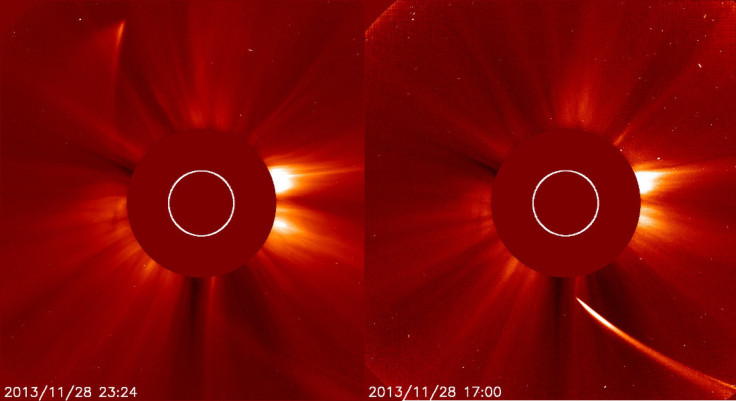Icy Comet ISON Destroyed In Suicidal Trip Around Sun; Will Its Remains Be Found? [VIDEO]

Comet ISON, the sun-grazing icy space projectile that travelled millions of years to enter the inner solar system, did not survive the sun’s enormous heat and was destroyed as it attempted to slingshot around the star on Thursday.
The comet, which was first discovered 585 million miles away on Sept. 21, 2012, was expected to sweep around the back of the sun, and emerge streaming a tail visible to the naked eye from Earth's skies in December. But, after solar telescopes tracked ISON passing just 730,000 miles from the sun’s surface on Thursday, astronomers did not spot any evidence of the comet on the other side of the star.
“We didn't see Comet ISON in SDO," Dean Pesnell, project scientist for NASA's Solar Dynamics Observatory, said in a statement. “So we think it must have broken up and evaporated before it reached perihelion.”
According to scientists, at closest approach, ISON was moving through the sun's atmosphere at speeds above 217 miles a second, and reaching temperatures of 5,000 degrees Fahrenheit, which was hot enough to vaporize not just ice, but also the dust and rock that made up the comet's structure. ISON also grew faint while within view of NASA's Solar Terrestrial Relations Observatory, and the European Space Agency and NASA's Solar and Heliospheric Observatory.
Based on all the evidence, astronomers concluded that ISON’s nucleus was torn apart in the close encounter. In 2011, Comet Lovejoy was destroyed in a similar manner, BBC reported.
“I'm not seeing anything that emerged from the behind the solar disk. That could be the nail in the coffin,” Karl Battams, a comet scientist with the Naval Research Laboratory in Washington, said during a live broadcast on NASA TV. “It's sad that it seemed to have ended this way, but we're going to learn more about this comet.”
Although ISON might have broken apart near the sun, scientists believe that its behavior in the sun's magnetic field will help unearth more information about both comets and the sun. According to NASA, if the comet has already broken up, it should have disintegrated completely, providing a great opportunity for scientists to see the insides of the comet, and better understand its composition.
Astronomers also said that if any large fragments of the comet survived its encounter with the sun, they would likely be visible to the naked eye in Earth's skies in a week or two, Reuters reported.
“I'd like to know what happened to our half-mile of material that was going around the sun,” Pesnell said. “We should be able to see something.”
According to Karl Battams, a comet scientist for the Naval Research Laboratory, it is believed remnants of ISON's nucleus might have survived perihelion.
"It now looks like some chunk of ISON's nucleus has indeed made it through the solar corona, and re-emerged," Battams was quoted by CNN as saying. "It's throwing off dust and (probably) gas, but we don't know how long it can sustain that."
Here is a collection of images from NASA that show comet ISON growing dim as it made the journey around the sun:
© Copyright IBTimes 2024. All rights reserved.






















